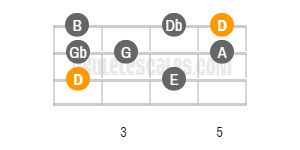

The sixth note of a major scale becomes the root note of its relative minor. The difference is the root note of the two scales.

For the Ab major scale, it’s A♭, B♭, C, D♭, E♭, F and G. The notes of the F minor scale as we’ve seen are F, G, A♭, B♭, C, D♭, and E♭. Minor keys and their relative major make use of the same notes. The relative major of F minor is Ab major. Here’s the F natural minor scale on piano. Here’s the F natural minor scale on the bass clef. Here’s a diagram of the F natural minor scale on the treble clef. Perfect 8th: F (one octave higher) is the 8th note of the B natural minor scale.Minor 7th: Eb is the 7th note of the scale.Minor 6th: Db is the 6th note of the scale.Perfect 5th: C is the 5th note of the scale.Perfect 4th: Bb is the 4th note of the scale.Minor 3rd: Ab is the 3rd note of the scale.Major 2nd: G is the 2nd note of the scale.Tonic: F is the 1st note of the F natural minor scale.To learn more about this scale and others, check out my course, Learn Scales & Music Theory & Give Yourself An Upper Hand. This scale consists of the pitches, F, G, A♭, B♭, C, D♭, and E♭. Let’s start with the F natural minor scale. We will take a look at the three types of minor scale, the natural minor, melodic minor and harmonic minor scales. This lesson is all about the F minor scale.


 0 kommentar(er)
0 kommentar(er)
